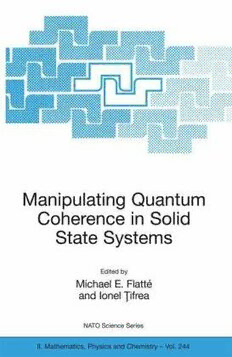
Manipulating quantum coherence in solid state systems PDF
Preview Manipulating quantum coherence in solid state systems
Manipulating Quantum Coherence in Solid State Systems NATO Science Series ASeries presenting the results of scientific meetings supported under the NATO Science Programme. The Series is published by IOS Press, Amsterdam, and Springer in conjunction with the NATO Public Diplomacy Division Sub-Series I. Life and Behavioural Sciences IOS Press II. Mathematics, Physics and Chemistry Springer III.Computer and Systems Science IOS Press IV.Earth and Environmental Sciences Springer The NATO Science Series continues the series of books published formerly as the NATO ASI Series. The NATO Science Programme offers support for collaboration in civil science between scientists of countries of the Euro-Atlantic Partnership Council. The types of scientific meeting generally supported are “Advanced Study Institutes” and “Advanced Research Workshops”, and the NATO Science Series collects together the results of these meetings. The meetings are co-organized bij scientists from NATO countries and scientists from NATO’s Partner countries – countries of the CIS and Central and Eastern Europe. Advanced Study Institutes are high-level tutorial courses offering in-depth study of latest advances in a field. Advanced Research Workshops are expert meetings aimed at critical assessment of a field, and identification of directions for future action. As a consequence of the restructuring of the NATO Science Programme in 1999, the NATO Science Series was re-organised to the four sub-series noted above. Please consult the following web sites for information on previous volumes published in the Series. http://www.nato.int/science http://www.springer.com http://www.iospress.nl 244 SeriesII:Mathematics,PhysicsandChemistry–Vol. Manipulating Quantum Coherence in Solid State Systems edited by Michael E. Flatté University of Iowa, Iowa City, U.S.A. and Ţ I. ifrea Babeş-Bolyai University, Cluj Napoca, Romania Published in cooperation with NATO Public Diplomacy Division Proceedings of the NATO Advanced Study Institute on Manipulating Quantum Coherence in Solid State Systems Cluj-Napoca, Romania 29 August–8 September 2005 AC.I.P. Catalogue record for this book is available from the Library of Congress. ISBN 978-1-4020-6135-6 (PB) ISBN 978-1-4020-6134-9 (HB) ISBN 978-1-4020-6137-0 (e-book) Published by Springer, P.O. Box 17, 3300 AADordrecht, The Netherlands. www.springer.com Printed on acid-free paper All Rights Reserved © 2007 Springer No part of this work may be reproduced, stored in a retrieval system, or transmitted in any form or by any means, electronic, mechanical, photocopying, microfilming, recording or otherwise, without written permission from the Publisher, with the exception of any material supplied specifically for the purpose of being entered and executed on a computer system, for exclusive use by the purchaser of the work. PREFACE The lectures at the NATO Advanced Study Institute “Manipulating Quantum Coherence in Solid State Systems” presented a fundamental introduction to three solid-state approaches to achieving quantum computation: semiconductor spin-based, semiconductor charge-based, and superconducting approaches. The purposeinbringingtogetherlecturersandstudentsinthesedisparateareaswasto provide the opportunity for communication and cross-fertilization between these three areas, all focusing on the central goal of manipulating quantum coherence insolids.Theseproceedingspresentdetailedintroductionstothefundamentalsof thefirstapproachandthethirdapproach,andassuchbringtogetherafundamental pedagogicaltreatmentofthetwoareaswhichhaveprogressedthefurthesttowards realizingascalablesystemofmanipulablequbits. Semiconductor spin-based approaches to quantum computation have made tremendousadvancesinthepastseveralyears.Individualspinshavebeensuccess- fully confined within self-assembled quantum dots and lithographically-formed quantum dots. Within the self-assembled quantum dots the spin lifetimes have beenmeasuredandshowntobelongerthan1msatlowtemperature.Lithographic dotshavebeenusedtocontrollablyreorientnuclearspinsinordertolengthenthe spin lifetimes. These exceptionally long spin lifetimes should permit many spin operations (qubit operations) within a decoherence time. Coherent spin transfer has also been demonstrated between two colloidal dots connected by polymer chains. Spins can be localized on dopant atoms, such as manganese atoms in galliumarsenide.Thesespinscanbeoriented,manipulatedanddetectedwithall- electrical means. Electrical techniques can also be used to manipulate nuclear spins,andeventuallytodrivenuclearmagneticresonance. The four chapters in this area are based on the lectures presented at the ASI byM.E.Flatte´,G.Vignale,I.T¸ifrea,andD.D.Awschalom,whichprogressfrom elementaryconsiderationsuptothechallengesthatmustbeovercomeinthenext few years to compete in the area of quantum computation with non-solid-state approaches. The first chapter provides an overview of several areas within this field, including spin transport and spin coherence times for ensembles of spins in bulk and quantum well materials, individual spin manipulation theory in ionic systemsandquantumdots,andtheapplicationofspin-basedquantuminformation to teleportation. The second chapter details the influence of many-body effects v vi PREFACE on spin transport, including the exciting area of the spin Hall effect. The third chapter focuses on the use of electric fields to manipulate nuclear spin lifetimes viathehyperfineinteractionwithelectronspins.Thefourthchapterdescribesthe electrical generation of spin polarization, the spin Hall effect, manipulation of spinviacontrolofthegtensor,transportofspincoherencebetweenquantumdots tethered by organic molecules, and the control of nuclear spin polarization with electricfields. Superconductingapproachestoquantumcomputationhavedemonstratedsin- gle qubits based on charge eigenstates as well as flux eigenstates. Each of these hasstrongpossibilitiesforscalability,andvisibleRabifloppinghasbeendemon- strated in each case. Coupling between these qubits has been demonstrated, and the decoherence mechanisms for single qubits have been explored. The fifth and sixthchaptersarebasedonthehighlypedagogicallecturespresentedbyM.Geller andF.WilhelmattheASI. The NATO ASI was held in Cluj-Napoca, Romania from August 29 to September 8, 2005, and it was attended by 10 lecturers and 65 students from 17differentcountries.Inadditiontothelectures,allstudentshadtheopportunity toorallypresenttheirownworkinoneoftwospecialafternoonseminarsessions. WewouldliketoacknowledgetheNATOScienceDivision,TheNationalSci- ence Foundation (USA), The Army Research Office (USA), and The Romanian Cultural Institute (ICR) for their financial contributions. Also, we would like to thank“Babes¸-Bolyai”UniversityandCityPlazaHotelfortheirhospitality. MichaelE.Flatte´ IonelT¸ifrea CONTENTS Preface v ListofParticipants viii M.E.Flatte´/SemiconductorSpintronicsforQuantumComputation 1 1 Introduction 1 2 Spin-DependentProcessesinElectricalTransport 2 3 SpinCoherenceTimesinSemiconductors 18 4 All-ElectricalControlofSingleIonSpinsinaSemiconductor 25 5 Single-SpinManipulationinQuantumDots 32 6 Spin-SelectiveDevices 42 7 Conclusion 45 G.Vignale/Many-bodyEffectsinSpin-polarizedTransport 53 1 Drift–DiffusionTheoryforCharge 53 2 Drift–DiffusionTheoryforCollinearSpins 55 3 SpinCoulombDrag—AnIntroduction 57 4 Drift–DiffusionTheory—Continued 59 5 SimpleApplications 62 6 MicroscopicTheoryofSpinCoulombDrag 72 7 ExperimentalObservationofSpinCoulombDrag 78 8 SpinMass 81 9 SpinHallEffect 86 10 Conclusion 93 Appendix 94 I.T¸ifrea/NuclearSpinDynamicsinSemiconductorNanostructures 97 1 Introduction 97 2 HyperfineInteractionandSpinRelaxationTimes 100 3 DynamicNuclearPolarization 106 4 InducedMagneticFields 112 5 OverhauserFrequencyShifts 116 6 Summary 120 Appendix 122 A TableofSemiconductorIsotopes 122 B ParabolicQuantumWells 124 vii viii CONTENTS J. Berezovsky, W. H. Lau, S. Ghosh, J. Stephens, N. P. Stern, andD.D.Awschalom/SpinCoherenceinSemiconductors 130 1 Introduction 130 2 ElectricalGenerationandManipulationofSpinPolarization 135 3 TheSpinHallEffect 140 4 Spin Accumulation in Forward-Biased MnAs/GaAs Schottky Diodes 152 5 SpinCoherenceinQuantumDots 161 M.R.Geller,E.J.Pritchett,A.T.Sornborger,andF.K.Wilhelm/ QuantumComputingwithSuperconductorsI:Architectures 171 1 Introduction 171 2 TheBasicQubits:Phase,Flux,andCharge 172 3 FixedLinearCouplings 180 4 TunableCouplings 184 5 DynamicCouplings:ResonatorCoupledQubits 187 F.K.Wilhelm,M.J.Storcz,U.Hartmann,andM.R.Geller/ SuperconductingQubitsII:Decoherence 195 1 Introduction 195 2 SingleQubitDecoherence 204 3 BeyondBloch–Redfield 219 4 DecoherenceinCoupledQubits 227 5 Summary 229 Index 234 LISTOFPARTICIPANTS LECTURERS GerhardAbstreiter,TechnisheUniversita¨tMu¨nchen,Germany DavidD.Awschalom,UniversityofCalifornia,SantaBarbara,USA MichaelE.Flatte´,UniversityofIowa,USA(co-director) MichealGeller,UniversityofGeorgia,USA LeonidGlatzman,UniversityofMinnesota,USA AdyStern,WeizmannInstituteofScience,Israel SeigoTarucha,UniversityofTokyo,Japan IonelT¸ifrea,“Babes¸-Bolyai”University,Romania(co-director) GiovanniVignale,UniversityofMissouri–Columbia,USA FrankWilhelm,Ludwig–MaximiliansUniversita¨tMu¨nchen,Germany STUDENTS AlexMatosAbiague,Max-PlanckInstitutfurMikrostrukturphysik,Germany AlexandruAldea,NationalInstituteofMaterialsPhysics,Romania RezaBakhtiari,ScuolaNormaleSuperiorePisa,Italy IgorBejenari,InstituteofAppliedPhysics,RepublicofMoldova JesseBerezovsky,UniversityofCalifornia,SantaBarbara,USA RafiBistritzer,WeizmannInstituteofScience,Israel DoruBodea,Max-PlankInstituteforPhysicsofComplexSystems,Germany ViorelLaurentiuCartas,UniversityofGalati,Romania MadalinaColci,UniversityofIllinois,USA BenjaminJCooley,PennStateUniversity,USA MirceaCrisan,“Babes¸-Bolyai”University,Romania IreneD’Amico,UniversityofYork,UnitedKingdom IonViorelDinu,NationalInstituteofMaterialsPhysics,Romania MatthewF.Doty,NavalResearchLaboratory,USA VitalieEremeev,InstituteofAppliedPhysics,RepublicofMoldova PeterFoldi,UniversityofSzeged,Hungary AndreasFriedrich,InstitutfurTheoretischePhysik,Germany LouisGaudreau,UniversityofSherbrooke,Canada ix
